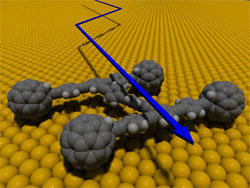Nanocars

Jim Tour is one of my favorite scientists. He does a lot of impressive work in the area of molecular electronics and nanoscience, which was my research field as a grad student and post doc. Tour is hard-working as hell, and has a sort of showman's flair for promoting his work that only occasionally spirals off into the hype that the field is infamous for. Now, though, his group has announced a piece of work that is both significant and yet 100% showboat: the nanocar.
The car (pictured in the molecular model above, riding on a street made of gold atoms ) is put together out of fairly straightforward parts, at least from a synthetic chemist's point of view. However, the wheels are fullerene, the 60-atom molecular allotrope of carbon that Tour's colleague at Rice, Richard Smalley, shared a Nobel prize for discovering. Fullerenes are really cool molecules for lots of reasons, but they are a nightmare to modify synthetically. So putting the wheels on this bad boy was a bitch.
Once they got the thing together, they dragged it along a gold surface with the tip of an atomic force microscope, and they showed that it rolls easier along the direction the wheels roll than from side to side. This isn't surprising to anyone who has played with a toy truck; however, in the nano-realm, it is relatively easy to just slide things around on surfaces. The data Tour's group collected suggests that the wheels are really rolling, and the car is not just sliding.
I don't expect GM will be producing these anytime soon. However, people have been hyping nanotechnology for over a decade now, and there have been many pretty pictures made of nanomachines. But there has been precious little real molecular demonstration of all this promise. This work is goofy, yet compelling, and it isn't musing or theory. It's a molecule that you can put in a bottle, and it's all the proof anyone needs that nanotech, though still an infant, has a lot of cool discoveries in store.


0 Comments:
Post a Comment
<< Home